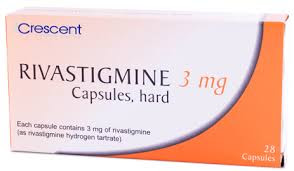Rivastigmine has the primary action of inhibiting:
- A. Acetyl cholinesterase
- B. Epinephrine
- C. Gastric acid
- D. Calcium influx
- E. Histamine release
The correct answer is: A. Acetyl cholinesterase
Rivastigmine is a cholinesterase inhibitor, which means it primarily acts by inhibiting the enzyme acetylcholinesterase. This enzyme breaks down acetylcholine, a neurotransmitter important for memory and learning. By inhibiting acetylcholinesterase, rivastigmine increases the levels of acetylcholine in the brain, which can improve cognitive function in individuals with conditions like Alzheimer's disease.
The other options are not primary actions of rivastigmine:
- B. Epinephrine: Epinephrine is a hormone and neurotransmitter involved in the "fight-or-flight" response. Rivastigmine does not directly affect epinephrine.
- C. Gastric acid: Rivastigmine does not have a significant effect on gastric acid secretion.
- D. Calcium influx: Calcium influx is involved in various cellular processes, but rivastigmine's primary action is on acetylcholinesterase.
- E. Histamine release: Histamine is involved in allergic reactions and inflammation. Rivastigmine does not directly affect histamine release.
Understanding Rivastigmine:
- Cholinesterase Inhibitor: Rivastigmine is a reversible acetylcholinesterase inhibitor, a class of drugs used to treat conditions like Alzheimer's disease and dementia.
- Mechanism of Action: By inhibiting acetylcholinesterase, rivastigmine increases the levels of acetylcholine, a neurotransmitter important for memory and learning. This can help to improve cognitive function in individuals with cognitive impairment.
Therapeutic Uses:
- Alzheimer's Disease: Rivastigmine is approved for the treatment of mild to moderate Alzheimer's disease.
- Dementia with Lewy Bodies: It is also used to treat dementia with Lewy bodies, a type of dementia characterized by cognitive decline, visual hallucinations, and motor symptoms.
Dosage and Administration:
- Oral Administration: Rivastigmine is typically administered orally in the form of capsules or oral solution.
- Dosage Adjustment: The dosage of rivastigmine may need to be adjusted over time based on the patient's response and tolerance.
Side Effects:
- Common Side Effects: Common side effects of rivastigmine include nausea, vomiting, diarrhea, weight loss, and fatigue.
- Serious Side Effects: In rare cases, rivastigmine can cause more serious side effects, such as bradycardia (slow heart rate), hypotension (low blood pressure), and gastrointestinal bleeding.
Drug Interactions:
- Other Medications: Rivastigmine may interact with other medications, including those used to treat heart conditions, respiratory problems, and muscle weakness. It is important to inform your doctor about all medications you are taking.
Monitoring and Management:
- Regular Monitoring: Patients taking rivastigmine should be monitored regularly by their healthcare provider to assess their response to the medication and to monitor for any side effects.
- Dosage Adjustments: The dosage of rivastigmine may need to be adjusted over time based on the patient's response and tolerance.
- Safety Considerations: Patients taking rivastigmine should be monitored for signs of gastrointestinal bleeding and should avoid activities that could increase the risk of falls, such as driving or operating heavy machinery.
Conclusion:
Rivastigmine is a valuable medication for the treatment of Alzheimer's disease and dementia with Lewy bodies. While it can improve cognitive function, it is important to be aware of its potential side effects and to take it as prescribed under the guidance of a healthcare professional.
